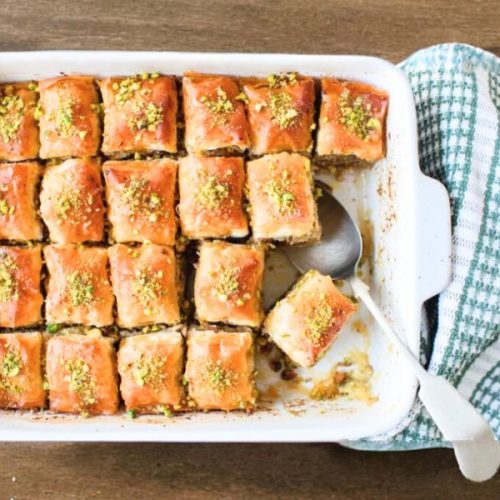
Easy & Tasty Baklava
Crisp layers of buttery phyllo, a rich blend of nuts and spices, and a fragrant honey-lemon syrup come together in this decadent yet approachable dessert. With minimal active cooking time and a make-ahead friendly nature, it’s a showstopper for holidays, celebrations, or a sweet weekday indulgence.
Equipment
- 1 Pastry brush
- 1 Food Processor
- 1 9x13-inch baking pan
- 1 Chef’s Knife
- 1 Small Saucepan
- 1 Mixing Bowl
- 1 Measuring cups & spoons set
Ingredients
For the Baklava:
- 454 g 1 lb mixed nuts (walnuts, pistachios, almonds, or combination)
- 454 g 1 lb phyllo dough, thawed
- 240 ml 1 cup unsalted butter, melted
- 67 g 1/3 cup granulated sugar
- 1 tsp ground cinnamon
- 1/3 tsp ground cloves
For the Syrup:
- 240 ml 1 cup water
- 200 g 1 cup granulated sugar
- 120 ml 1/2 cup honey
- 2 tbsp lemon juice
- 1 cinnamon stick
- Finely ground pistachios for garnish optional
Instructions
- Thawing the Phyllo Dough: Thaw the phyllo dough carefully by transferring it from the freezer to the refrigerator the night before you plan to bake, allowing it to soften gradually. Keep the dough wrapped in its original packaging or cover with plastic wrap to prevent it from drying out. Handle gently when ready to use, as phyllo is delicate and can tear easily if rushed.
- Preheating and Preparing the Pan: Prepare your baking environment by preheating the oven to 350°F (175°C) to ensure even cooking. Lightly grease a 9x13-inch baking pan with butter or nonstick spray to prevent sticking. This step ensures the baklava bakes evenly and releases cleanly from the pan when finished.
- Preparing the Nut Filling: Pulse the nuts for uniform texture using a food processor until they are finely chopped but not powdered, preserving a little bite for texture. Transfer to a mixing bowl and blend in sugar, cinnamon, and ground cloves, combining the flavors thoroughly. This mixture forms the flavorful core of the baklava, giving every bite a rich, aromatic crunch.
- Melting the Butter: Melt the butter gently in a small saucepan or microwave-safe bowl until fully liquid and warm, making it easy to brush onto phyllo layers. Keep it warm as you work to prevent the phyllo from cooling too quickly, which can cause it to crack. Buttering each layer ensures the baklava turns crisp, golden, and evenly cooked.
- Layering the First Phyllo Sheets: Create the base layers of phyllo by placing a sheet into the prepared pan and brushing it generously with melted butter. Repeat this process with 7 more sheets, creating a sturdy, buttery foundation that will support the nut filling while producing delicate, crisp layers. Cover unused sheets with a damp towel to prevent drying while you work.
- Adding the Nut Filling: Spread a thin, even layer of the nut mixture over the phyllo base, ensuring the layer reaches the edges but isn’t too thick. Then, carefully place two more phyllo sheets on top, brushing each with melted butter, creating alternating layers of nut filling and phyllo. Repeat this process until all the nut mixture is used, finishing with 8 buttered phyllo sheets on top.
- Scoring the Baklava: Score the layered baklava carefully using a sharp chef’s knife, cutting through all layers to form 24 evenly sized squares. Scoring ensures the syrup penetrates each piece fully and makes cutting the finished baklava clean and easy. A precise score also helps the baklava bake evenly without cracking or puffing irregularly.
- Baking the Baklava: Bake the baklava evenly at 350°F (175°C) for 30–35 minutes, or until the top layers are golden brown and crisp at the edges. Monitor closely to prevent over-browning, rotating the pan if necessary for uniform color. Baking transforms the delicate layers into a crisp, flaky masterpiece with a rich aroma filling the kitchen.
- Preparing the Honey Syrup: Simmer the honey syrup gently by combining water, sugar, honey, lemon juice, and a cinnamon stick in a small saucepan. Bring to a boil, then reduce heat to medium-low and simmer for about 7 minutes until slightly thickened, stirring occasionally to dissolve sugar completely. Remove the cinnamon stick and allow the syrup to cool to room temperature before pouring over hot baklava.
- Pouring the Syrup: Spoon the cooled syrup evenly over the hot baked baklava, ensuring every cut and corner absorbs the liquid. The syrup will seep into the scored lines and infuse the nuts, giving a sweet, sticky finish that contrasts perfectly with the crisp phyllo. Let the baklava rest uncovered for at least 4 hours to fully absorb the syrup and achieve the ideal texture
Notes
- Thaw phyllo properly: Always thaw phyllo dough in the refrigerator overnight to prevent tearing and ensure pliability.
- Keep phyllo covered: Place a damp towel over sheets while working to stop them from drying out.
- Nut variations: Use any combination of walnuts, pistachios, and almonds, or try pecans or hazelnuts for a personal twist.
- Butter generously: Brushing each layer ensures a crisp, golden texture; don’t skimp.
- Syrup timing: Pour cooled syrup over hot baklava to allow proper absorption without sogginess.
- Scoring carefully: Score before baking to make cutting easier and ensure syrup penetration.
- Make-ahead friendly: Baklava can be made a day or two in advance; flavor improves as it rests.